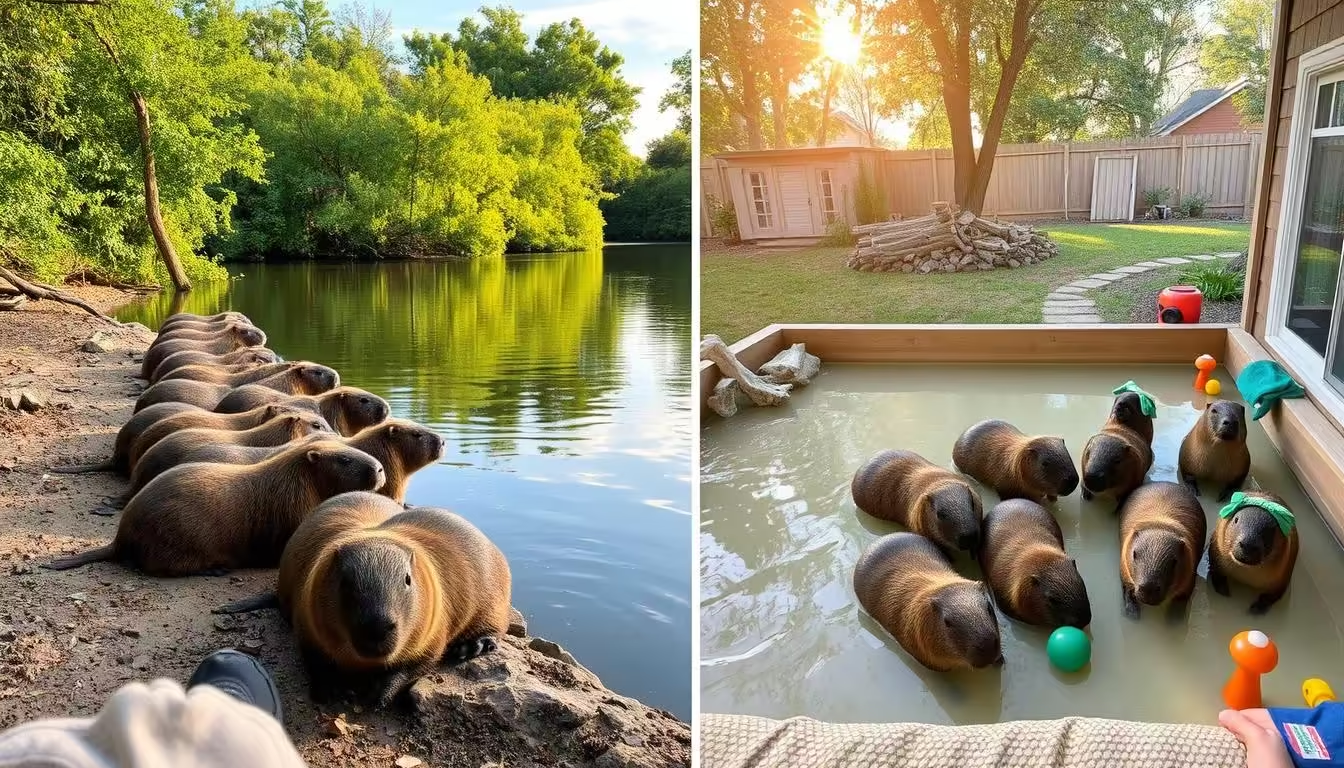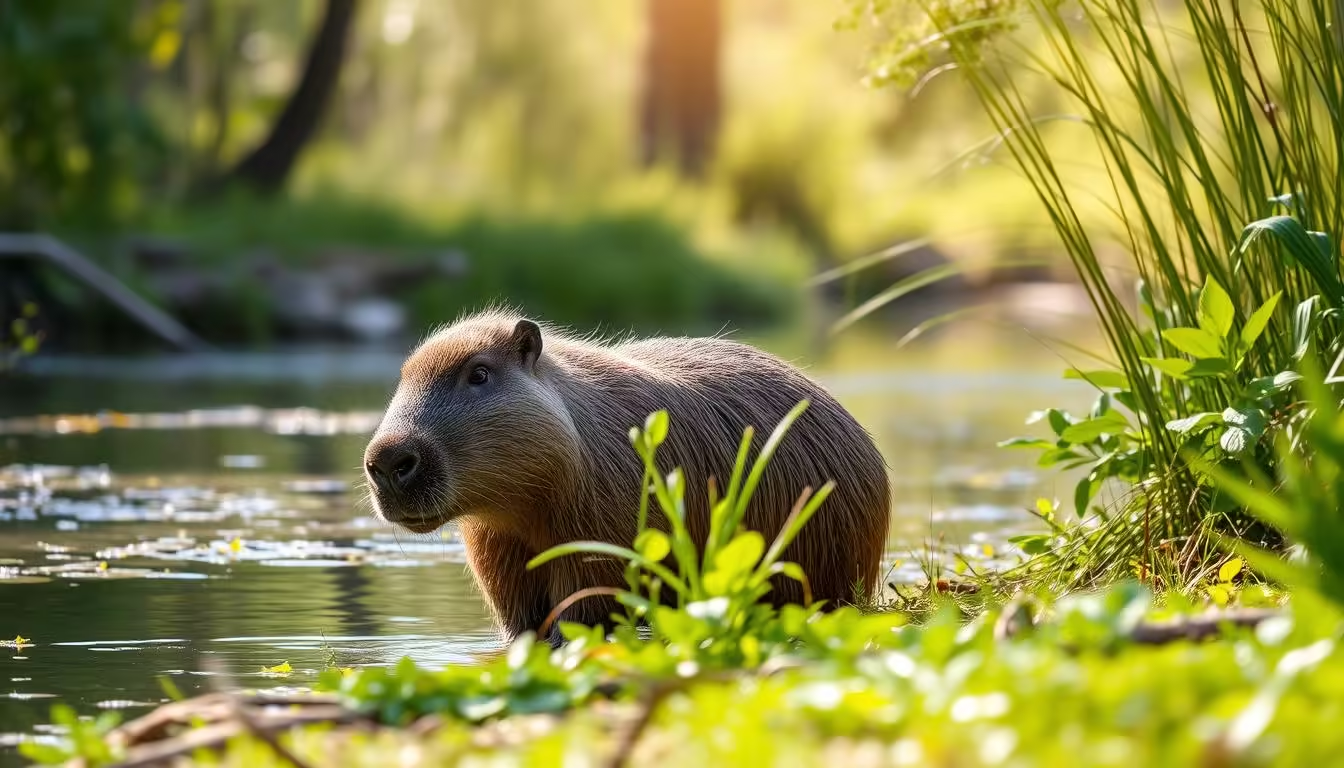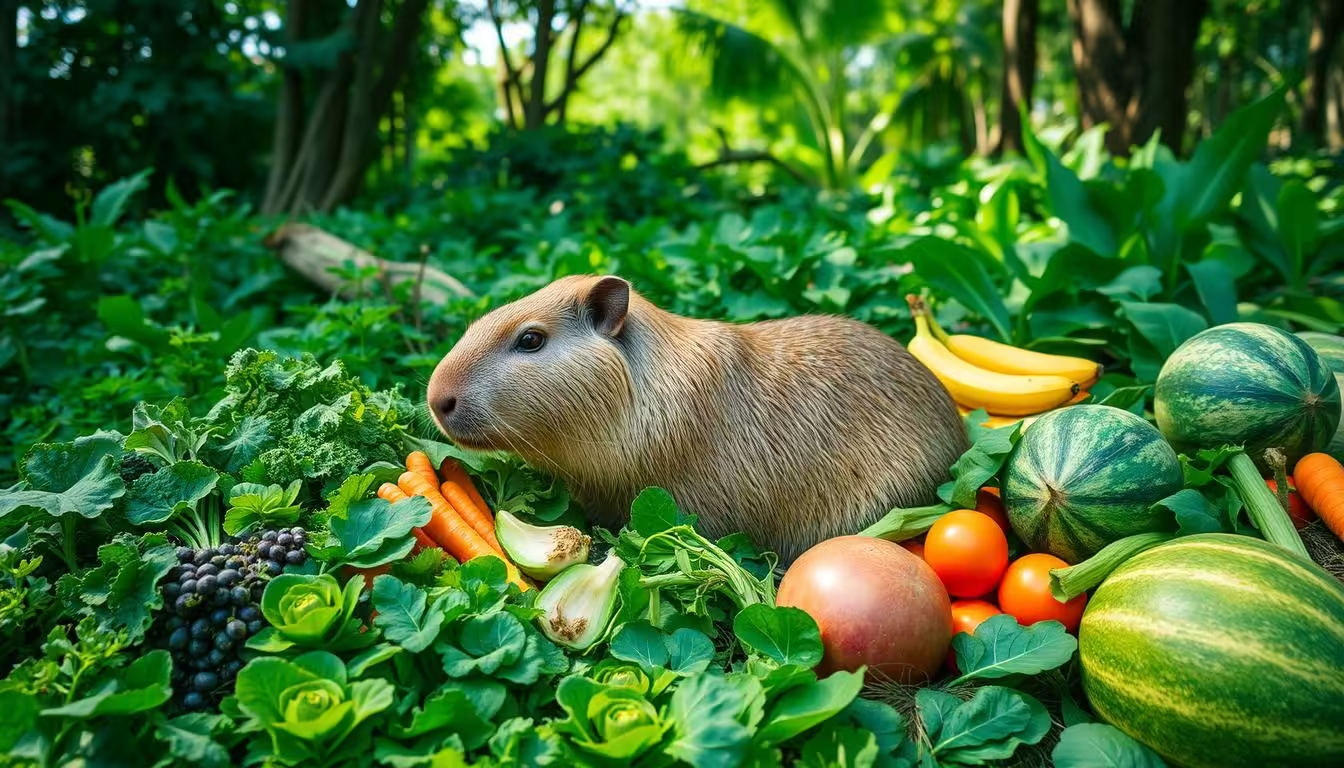Capybaras, the world’s largest rodents, live in Central and South America. Their lifespan changes a lot depending on where they live. Knowing what affects capybara lifespan is key for those who want to keep them as pets or help protect them.
In the wild, wild capybaras usually live 4 to 8 years, averaging 6 years. But, captive capybaras can live up to 12 years, much longer than their wild counterparts. This shows how important it is to give them the right home, food, and friends to stay healthy.
Key Takeaways
- The average lifespan of capybaras in the wild is 4-8 years, while in captivity, they can live up to 12 years.
- Capybaras are social animals that require specific care and living conditions to thrive.
- Proper diet, habitat, and environmental factors can significantly impact the longevity of captive capybaras.
- Capybaras are legal in some U.S. states, but ownership requirements may vary and should be researched.
- Caring for capybaras can be costly due to their large size and habitat needs.
Understanding Capybaras: The World’s Largest Rodents
Capybaras are the giants of the rodent world. They are the largest living rodents, weighing up to 150 pounds and standing 24 inches tall. Their stocky build, short legs, and webbed feet make them perfect for life in the water.
Physical Characteristics
Capybaras have big, rounded heads and small ears. Their thick, coarse coat can be reddish-brown to grayish-brown. Female capybaras are usually heavier than males. They can dive for up to 5 minutes and run fast, reaching speeds of 35 kilometers per hour.
Natural Habitat Range
Capybaras live in a wide area, mainly east of the Andes in South America. They are found from Panama to Northern Argentina. They thrive in rainforests, grasslands, and marshes, up to 1,500 meters high.
Scientific Classification
Capybaras belong to the genus Hydrochoerus, meaning “water hog” in Latin. There are two types: the Greater Capybara (Hydrochoerus hydrochaeris) and the Lesser Capybara (Hydrochoerus isthmius). Both make different sounds to communicate, like purring and squealing.
Capybaras are truly remarkable. Their size, adaptability, and behaviors make them fascinating. As the world’s largest rodents, they inspire and captivate people everywhere.
What Is the Average Lifespan of a Capybara in the Wild vs. Captivity?
Capybaras, the world’s largest rodents, live differently in the wild and in captivity. Capybaras in the wild can live up to 8 to 10 years. But, those in captive settings can live over 12 years of age. This shows how important habitat, care, and environment are for their long life.
In the wild, capybaras face many challenges. Predators, lack of food, and harsh environments can shorten their lives. But, with the right care, food, and safe places in captivity, they can live much longer.
| Lifespan Comparison | Wild Capybaras | Captive Capybaras |
|---|---|---|
| Average Lifespan | 8 to 10 years | Over 12 years |
| Factors Affecting Lifespan | Predation, resource scarcity, environmental stressors | Proper care, nutrition, protected living conditions |
The longer life of capybaras in captivity shows the need for proper care. By giving them the right resources and safe places, we can help them live longer. This also helps us understand their role in nature.
Natural Habitat and Living Conditions
Capybaras, the world’s largest rodents, live in tropical climates with water nearby. They live in groups of 10 to 30 in South America. Their homes get about 2.3 meters of rain each year, with dry and wet seasons.
Climate Requirements
Capybaras can handle temperatures from 4°C (40°F) to 32–38°C (90–100°F). They need water and shade to stay cool. Indoors, they prefer humidity between 30% and 70%.
Social Structure in the Wild
In the wild, capybaras live in groups of up to 100. These groups have a leader male, adult females, and young. The leader male guards the group and is key to their social order.
Territory and Space Needs
Capybaras need big areas with water for swimming and eating. They eat grasses and plants. They play a big role in their ecosystems, so it’s important to protect their homes and give them enough space.
“Capybaras are strictly South American rodents found throughout Brazil, Uruguay, Venezuela, Colombia, southern Argentina, and into the Andes.”
Factors Affecting Wild Capybara Longevity
The lifespan of wild capybaras can be affected by many things. These include predation, habitat quality, food availability, and environmental stressors. As the world’s largest rodent, capybaras face threats from nature and humans.
Predation is a big factor. These gentle giants are hunted by foxes, bush dogs, jaguars, and eagles. Jaguars often target young or male capybaras that stray from the herd.
Habitat quality and food availability also play a role. Water pollution from mining and oil can harm their homes. Human activities and development can also reduce their living spaces. Changes in food sources like grasses and aquatic plants add to their challenges.
- Female capybaras in the wild have a typical life expectancy of 7 to 10 years.
- Capybara litters usually consist of 4 to 5 pups, with breeding groups potentially having 15 pups or more.
- Capybaras have an average lifespan of 6 years in the wild and can live up to 10 years.
Despite these challenges, the IUCN Red List of Threatened Species lists capybaras as “Least Concern.” This is because they are found widely and have large populations. However, some local populations are declining due to hunting, even in protected areas. Conservation and habitat preservation are key to their survival.
“In the wild, capybaras are preyed upon by various animals such as foxes, bush dogs, jaguars, and eagles, alongside human hunters.”
Captive Environment Requirements
Caring for capybaras in captivity needs careful attention to their environment. These large rodents have specific needs for their enclosures, temperature, humidity, and water. Meeting these requirements is key to their health and long life.
Enclosure Specifications
Capybaras need big enclosures with land and water. For an adult pair or trio, a 12 ft. x 20 ft. (240 sq. ft.) outdoor area is best. This size lets them move and play together. Their indoor homes should look like their natural habitat, with no furniture and lots of plants and logs for comfort and fun.
Temperature and Humidity Control
Capybaras can handle many temperatures, from 10°F (-12°C) to 90-100°F (32-38°C). But, they need shelter and water to stay healthy. Indoor spaces need heating and cooling systems and backup power to keep the right temperature and humidity, between 40-70%.
Water Features and Pool Requirements
Water is very important for capybaras, as they love both land and water. Their enclosures should have a pool at least 6 ft. (1.84 m) deep for swimming and playing. The pool must have a filter, as capybaras often poop in the water. Cleaning and disinfecting the pool regularly is important to keep it clean and safe for them.
| Captive Capybara Care Requirements | Specifications |
|---|---|
| Average Weight (Captive Adult) | Male: 50 kg, Female: 61 kg |
| Outdoor Temperature Range Tolerance | 10°F (-12°C) to 90-100°F (32-38°C) |
| Minimum Outdoor Exhibit Size (Adult Pair/Trio) | 12 ft. x 20 ft. (240 sq. ft.) |
| Pool Depth Recommendation | 6 ft. (1.84 m) |
| Humidity Range (Indoor Enclosures) | 40-70% |
| Light Cycle Recommendation | 12-hour light, 12-hour dark |
By creating the right environment for capybaras, we can help them live long, happy lives. In captivity, they can live up to 12 years, much longer than their 4-8 years in the wild.
Diet and Nutrition Impact on Lifespan
Capybaras, the world’s largest rodents, are herbivores. They eat a variety of plants to stay healthy and live long. In the wild, they can eat up to 8 pounds of plants every day. This includes grasses, aquatic plants, and sometimes fruits or tree bark.
In captivity, it’s important to give capybaras the right capybara nutrition. They need a diet rich in hay, fresh veggies, and fruits. They also need vitamin C to avoid scurvy. A good diet helps them stay physically and mentally healthy.
As capybaras get older, their bodies change. They can’t absorb nutrients as well. Around 70% of their life in captivity, their diet should change. More protein, vitamins, and omega-3 fatty acids help them stay well.
Older capybaras need to eat more often. They have trouble absorbing nutrients. Giving them soft, nutritious food helps them stay healthy.
| Key Nutrients for Capybara Longevity | Benefits |
|---|---|
| Protein | Supports muscle mass and overall health in aging capybaras |
| Vitamins | Helps maintain immune function, cognitive abilities, and physical performance |
| Omega-3 Fatty Acids | Reduce inflammation and support cardiovascular and brain health |
By giving capybaras a balanced diet, we can help them live longer and healthier lives. This is true for both those in captivity and in the wild.
Social Needs and Group Dynamics
Capybaras are very social and do best in groups. In the wild, they live in tight-knit herds. These herds have one dominant male, several females, and their kids. This social setup is key for their happiness and health.
Herd Structure
The capybara herd has a clear hierarchy. The top male leads the group. Females and their young do things together like grooming and resting. The leader protects the group and keeps order, sometimes being aggressive to younger males.
Social Bonding Requirements
- Capybaras need to be around others and have the right mix of ages and sexes to be happy.
- Good relationships between group members are vital for their mental and physical health. They feel safe and united.
- Changing the group’s structure, like removing a leader or adding new capybaras, can cause stress and fights.
Keeping the right capybara social behavior and capybara herd dynamics is key. It’s important for their long-term health and happiness, whether they’re in the wild or in captivity.
| Characteristic | Wild Capybaras | Captive Capybaras |
|---|---|---|
| Herd Structure | Typically one dominant male, several females, and their offspring | Balanced age and sex ratio essential for social well-being |
| Social Bonding | Strong social bonds within the herd for security and cohesion | Disruption of social structure can lead to stress and aggression |
| Behavioral Needs | Cooperative activities like grooming, resting, and vigilance | Provision of appropriate social environment crucial for mental health |
Health Considerations in Captivity
Keeping captive capybaras healthy is key to their happiness and long life. They need regular vet visits for shots and health checks. Keeping their home clean and water fresh is also important to stop diseases.
It’s also important to watch for signs of stress in capybaras. Look out for too much noise, being very tired, or not wanting to eat. Giving them a big, interesting place to live can help them feel better.
Owners should know that capybaras can carry diseases like ringworm and salmonella. Washing hands often and keeping things clean helps prevent these diseases from spreading. This keeps everyone safe, including other pets in the house.



